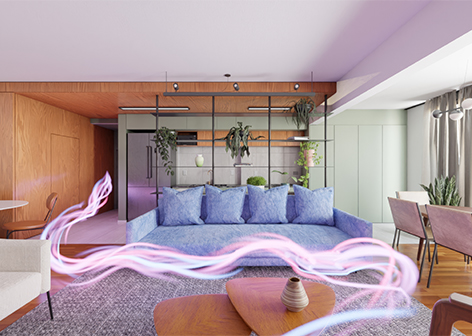
Allergies and asthma have become increasingly common in modern indoor environments. While outdoor pollution often takes the blame, the truth is that the air inside buildings—homes, offices, gyms, and other indoor spaces—can be up to five times more polluted than the air outside. Invisible allergens and airborne irritants can quietly build up, triggering sneezing, coughing, shortness of breath, and even full-blown asthma attacks.
The good news? With today’s technology, it’s possible to identify and manage these triggers effectively. Air quality monitors, such as those offered by Oxyiot, play a vital role in keeping indoor air safe and breathable. By tracking pollutants in real time, they empower individuals and businesses to create environments that promote health and well-being.
In this blog, we’ll explore how air quality monitors can help reduce allergies and asthma attacks—and why investing in one is an essential step toward a healthier lifestyle.
1. Understanding the Link Between Air Quality and Respiratory Health
Indoor air quality has a direct impact on allergy and asthma symptoms. The air we breathe indoors contains a mixture of pollutants such as dust, pollen, volatile organic compounds (VOCs), mold spores, and fine particulate matter (PM2.5). For people with sensitive airways, even small fluctuations in these pollutant levels can trigger uncomfortable or dangerous reactions.
Studies show that exposure to poor indoor air quality can increase both the frequency and severity of asthma attacks. Common allergens like dust mites, pet dander, and mold thrive in poorly ventilated spaces, while chemicals from cleaning agents or new furniture release VOCs that further irritate the respiratory system.
This is where a smart air quality monitor makes all the difference—it acts as your eyes and ears for invisible pollutants that affect breathing comfort and overall health.
2. How Air Quality Monitors Detect Common Allergy and Asthma Triggers
Modern air quality monitors, like Oxyiot, are designed with precision sensors capable of detecting multiple indoor air pollutants simultaneously. Here’s how they help identify major asthma and allergy triggers:
a. Particulate Matter (PM2.5 and PM10)
Tiny airborne particles from dust, smoke, or outdoor pollution can easily penetrate deep into the lungs. Oxyiot continuously tracks these particles in real time, alerting you when levels rise so you can take immediate action—like adjusting ventilation or cleaning filters.
b. Volatile Organic Compounds (VOCs)
Many household items release VOCs—from cleaning sprays to paint and scented products. Prolonged exposure to VOCs can irritate the lungs and worsen asthma symptoms. Oxyiot sensors detect even low-level VOC concentrations, helping identify problem sources before they escalate.
c. Carbon Dioxide (CO₂)
While CO₂ is not an allergen, elevated levels indicate poor ventilation. Stale air traps allergens and dust indoors, creating a breeding ground for respiratory issues. Oxyiot monitors CO₂ in real time, signaling when it’s time to increase airflow.
d. Humidity and Temperature
Humidity plays a key role in respiratory health. Too much humidity encourages mold growth, while overly dry air irritates nasal passages. Oxyiot helps maintain the ideal humidity balance by providing continuous monitoring and alerts when levels stray outside the comfort zone.
3. Real-Time Alerts Prevent Exposure Before It’s Too Late
One of the biggest advantages of Oxyiot’s air quality monitoring system is real-time alerting. Instead of discovering an issue after allergy symptoms begin, users receive instant notifications when pollutant levels cross safe thresholds.
For example:
In a fitness space, if PM2.5 or CO₂ levels suddenly rise due to heavy occupancy, Oxyiot sends an alert to facility managers to improve ventilation.
In wellness centers, when humidity levels increase—creating a risk for mold growth—the system provides timely notifications to act before it spreads.
This proactive approach reduces prolonged exposure to harmful allergens, helping prevent allergy flare-ups and asthma attacks before they happen.
4. Data Trends That Reveal Hidden Problems
Air quality monitors don’t just display numbers—they store and analyze data over time. Oxyiot’s cloud-based analytics allow users to identify recurring pollution patterns that might go unnoticed in daily observation.
For instance, you might discover that VOC levels spike during certain cleaning hours or that particulate matter increases after peak gym sessions. With this insight, you can modify schedules, improve ventilation, or use safer cleaning agents—all of which directly contribute to reducing allergic and asthmatic triggers.
This data-driven approach turns guesswork into actionable health strategies.
5. Smart Integration with Ventilation and HVAC Systems
While many basic air monitors simply measure pollutants, Oxyiot goes a step further by integrating with HVAC systems. When pollutant levels exceed safe limits, Oxyiot can automatically adjust ventilation settings to restore clean air conditions.
This feature is especially beneficial in spaces with fluctuating occupancy—such as gyms, offices, or wellness centers—where pollutant levels can rise rapidly. By maintaining optimal airflow and filtration in real time, Oxyiot helps prevent the buildup of allergens and irritants, ensuring that occupants continue to breathe comfortably.
6. Empowering Individuals and Businesses to Take Control
Air quality monitoring isn’t just about technology—it’s about empowerment. For individuals, it provides awareness and control over their environment. For organizations, it demonstrates a commitment to health, safety, and wellness.
Businesses that use Oxyiot’s air quality monitors can:
Protect staff and customers from respiratory triggers.
Enhance productivity, as clean air reduces fatigue and discomfort.
Build trust by showing a proactive approach to environmental health.
Clean air is no longer a luxury—it’s a necessity that directly impacts performance, satisfaction, and well-being.
7. Why Oxyiot Stands Out
Oxyiot’s air quality monitors are specifically engineered for commercial and high-traffic indoor spaces, offering a perfect blend of accuracy, usability, and reliability. Here’s what sets Oxyiot apart:
Multi-sensor precision tracking PM, CO₂, VOCs, humidity, and temperature.
Instant alerts and reports via app, SMS, or email.
Cloud-based analytics for long-term monitoring and pattern recognition.
Smart HVAC connectivity for automatic air management.
User-friendly design with visual indicators that anyone can interpret.
By combining smart technology with actionable data, Oxyiot ensures that every breath taken indoors is cleaner and safer.
Conclusion
Allergies and asthma may not be entirely preventable, but managing their triggers is absolutely within reach. Invisible pollutants are often the root cause of recurring respiratory discomfort—and thanks to modern technology, they no longer have to remain invisible.
With Oxyiot’s advanced air quality monitoring systems, businesses and individuals can detect harmful allergens, maintain ideal environmental conditions, and take timely action to prevent flare-ups.
Cleaner air means healthier lives—and Oxyiot makes that goal achievable every single day.




